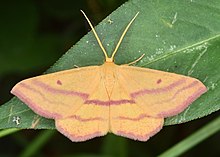| Haematopis | |
|---|---|

| |
| Scientific classification | |
| Domain: | Eukaryota |
| Kingdom: | Animalia |
| Phylum: | Arthropoda |
| Class: | Insecta |
| Order: | Lepidoptera |
| Family: | Geometridae |
| Subfamily: | Sterrhinae |
| Tribe: | Timandrini |
| Genus: | Haematopis Hübner, 1823 |
| Species: | H. grataria |
| Binomial name | |
| Haematopis grataria (Fabricius, 1798) | |
| Synonyms | |
| |
Haematopis is a monotypic moth genus in the family Geometridae erected by Jacob Hübner in 1823. Its only species, Haematopis grataria, the chickweed geometer, was first described by Johan Christian Fabricius in 1823. It is found throughout the United States. In Canada it is found from Quebec to Alberta, north to the Northwest Territories.
The wingspan is 20–25 mm (About 3/4–1 in). Adults are on wing from May to October. It is a day-flying species.
The larvae feed on various low-growing plants, including Stellaria, Polygonum and clover.
Description
Adults of this species rest with their wings held out flat and to their sides. Their wings are a pale yellow, and their forewings each have a small red or pink spot in the center. Both the forewings and the hindwings each have two pink or red bands, which appear to be continuous across both sets of wings when the moth is in its resting position. Male chickweed geometers have feathered antennae, while females have thinner, thread-like antennae.
References
- Savela, Markku. "Haematopis Hübner, 1823". Lepidoptera and Some Other Life Forms. Retrieved May 28, 2019.
- "Chickweed Geometer". MDC Discover Nature. Retrieved 2021-04-29.
External links
- McLeod, Robin (February 11, 2019). "Species Haematopis grataria - Chickweed Geometer - Hodges#7146". BugGuide. Retrieved May 28, 2019.
- "910554.00 – 7146 – Haematopis grataria – Chickweed Geometer Moth – (Fabricius, 1798)". North American Moth Photographers Group. Mississippi State University. Retrieved May 28, 2019.
- Anweiler, G. G. (November 23, 2003). "Species Details Haematopis grataria". University of Alberta Museums. E.H. Strickland Entomological Museum. Retrieved November 10, 2020.
| Taxon identifiers | |
|---|---|
| Haematopis | |
| Haematopis grataria | |
This Sterrhinae moth related article is a stub. You can help Misplaced Pages by expanding it. |